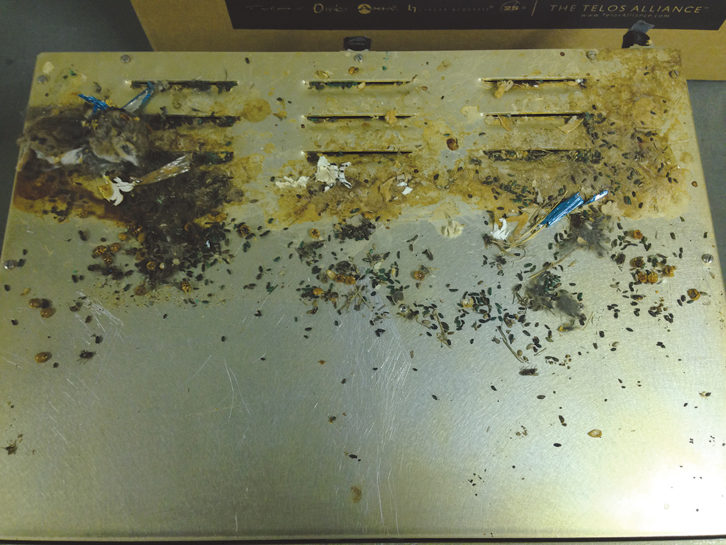“The early bird gets the worm, but the second mouse gets the cheese.”
Component old age is not the only cause of equipment failures. Another, more disgusting, one is vermin infestation, which will become common again now that cooler weather is upon much of the nation.
If you haven’t taken steps to place bait traps and moth balls around your remote transmitter site, now is the time. All sorts of animals are attracted to the warmth of your transmitter building; and they will quickly set up home, sometimes in or on your equipment. See Fig. 1.

Stop the problem before it begins. Rodents like to travel along walls; place your glue or bait traps there to snag them before they get into your equipment racks.
Little black mouse droppings on the floor of the building or enclosure are a signal for action. If you find that your site has been infested, protect yourself while removing nest and droppings. Wear gloves, a gown and above all a mask to avoid breathing hazardous airborne pathogens.

John Wells has written a useful tutorial on illnesses spread by rodents and offers useful tips to ensure their removal. The URL is in the caption for Fig. 2. YouTube also has a number of videos; search “removing mouse infestation” for tips.
***
Broadcast engineer Tom Norman read with interest our discussion about Frank Hertel’s experience with electrolytic capacitors in an FM exciter. It brought back memories that may be useful for other readers.
Tom remembered an instance in which a remote control system failed. His tests couldn’t produce a reason, but its operation remained horribly intermittent. Tom decided to station himself at the transmitter site until he could figure out what was wrong.
He started with the usual, checking power supply voltages using a VOM. No issues. He checked the same power supply rails with the ’scope. Still nothing wrong.
At one point in the circuit, one of the power supply voltages was further regulated using a three-terminal regulator. Scoping the output of that regulator, he hit the regulator with freeze mist. The tiny amount of ripple disappeared. Tom is not sure what possessed him to check the input terminal of the regulator, but when he did he saw significant ripple. Why was there more ripple on the input of this chip than was present at the output of the regulated power supply feeding it? He froze the chip again and it calmed down.
Tom replaced the chip. No difference. That’s when he considered what was attached to the input and output terminals of the chip. You guessed it: There was a small electrolytic on the input. Tom replaced it. The power supply calmed down, but he still had erratic behavior from the remote control unit.
Tom’s next step was to freeze mist all the active components. He was about to freeze a 741 Op Amp but inadvertently touched it with the little straw from the nozzle of the can of mist. The remote control unit went from erratic to totally dead. He poked the Op Amp again, no difference. He froze it. Back to erratic operation. Tom replaced the Op Amp. Operation was still erratic. Checking the schematic, he noted power supply bypass electrolytic capacitors on the power supply pins. Tom replaced those capacitors. Still erratic.
Pulling out what little was left of hair, he removed the Op Amp and stuffed in a fresh one. Problem solved.
This all took place shortly after a huge electrical storm during which Tom had witnessed multiple direct strikes to the tower.
Although not certain, Tom sees two issues here. One is that lightning can affect components deep inside a circuit, where normally you’d expect them to be safe and sound. His guess is that the electrolytics, being old, failed due to the exacerbating influence of the lightning. Then, for reasons he cannot fathom, one or the other of the Op Amp’s power supply bypass capacitors became inductive and caused oscillations whose peak voltages exceeded the limits of the 741 Op Amp, thus frying it. Although this is speculation, it reminds us that electrolytics should be replaced every seven years or so.
Tom also recalls that as a station engineer, when he found Mallory-brand electrolytic capacitors in a piece of equipment, he would shotgun all of them. He said he’d had so much difficulty with Mallory electrolytic capacitors that he specified that new equipment must not contain any electrolytic capacitors of that manufacture.
Tom writes that he still carries this prejudice, even while acknowledging that things may have changed since then. He doesn’t do much bench work now, but from time to time he will design little circuits for use in his home environment, and when he orders capacitors, he selects another manufacturer — which is funny, because Tom has never had a Mallory Sonalert fail.
Contribute to Workbench. You’ll help your fellow engineers and qualify for SBE recertification credit. Send Workbench tips and high-resolution photos to johnpbisset@gmail.com.
John Bisset has spent 50 years in the broadcasting industry and is still learning. He handles western U.S. radio sales for the Telos Alliance. He holds CPBE certification with the Society of Broadcast Engineers and is a past recipient of the SBE’s Educator of the Year Award.







